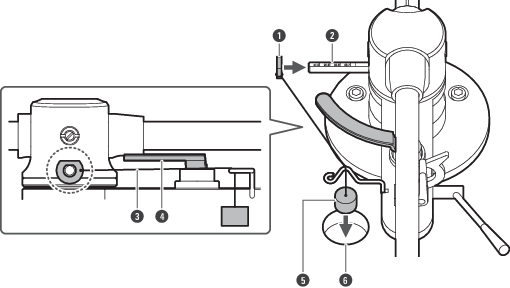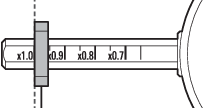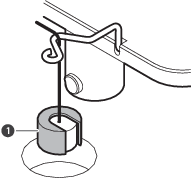Setting the anti-skate adjustment
While the record is playing, a force acts on the stylus tip to pull it inward. This force can be counteracted by setting the multiplier for the weight for anti-skate according to the tracking force value.
- If using a cartridge other than the included cartridge, depending on the tracking force, it may be necessary to make adjustments by adding the auxiliary weight for anti-skate.
-
Place the weight for anti-skate into the slot in the turntable body and slide the ring onto the anti-skate bar.
- Pass the weight for anti-skate string under the tonearm lift.
- Attach the anti-skate bar in the direction shown in the figure. Take care not to mistake the attachment direction.

- Ring
- Anti-skate bar
- String
- Tonearm lift
- Weight for anti-skate
- Slot
-
Adjust the position of the ring on the anti-skate bar to set the proper weight for anti-skate multiplier for the tracking force setting on the counterweight.
- Using the left side of the ring as a reference, align with the multiplier scale.
- If using the included cartridge, set to “1.0”. If using a cartridge other than the included cartridge, see If using a cartridge other than the included cartridge.

If using a cartridge other than the included cartridge
Calculate the weight and anti-skate multiplier to be used based on the proper tracking force of the cartridge being used.
- Two types of weights are used: 2.0 g (0.071 oz) (weight for anti-skate only) and 3.0 g (0.11 oz) (weight for anti-skate + auxiliary weight for anti-skate). If the proper tracking force is 2.0 g (0.071 oz) or less, use the 2.0 g (0.071 oz) weight. If 2.1 g (0.074 oz) or more, use the 3.0 g (0.11 oz) weight.
- The anti-skate multiplier can be calculated by dividing the proper tracking force by the weight.
| Proper cartridge tracking force | Weight used | Anti-skate multiplier |
|---|---|---|
| 1.3 g (0.046 oz) [1] | 2.0 g (0.071 oz) | 0.65 |
| 1.4 g (0.049 oz) | 0.7 | |
| 1.5 g (0.053 oz) | 0.75 | |
| 1.6 g (0.056 oz) | 0.8 | |
| 1.7 g (0.060 oz) | 0.85 | |
| 1.8 g (0.063 oz) | 0.9 | |
| 1.9 g (0.067 oz) | 0.95 | |
| 2.0 g (0.071 oz) (included cartridge) | 1.0 | |
| 2.1 g (0.074 oz) | 3.0 g (0.11 oz) | 0.7 |
| 2.2 g (0.078 oz) | 0.73 | |
| 2.3 g (0.081 oz) | 0.77 | |
| 2.4 g (0.085 oz) | 0.8 | |
| 2.5 g (0.088 oz) | 0.83 | |
| 2.6 g (0.092 oz) | 0.87 | |
| 2.7 g (0.095 oz) | 0.9 | |
| 2.8 g (0.099 oz) | 0.93 | |
| 2.9 g (0.10 oz) | 0.97 | |
| 3.0 g (0.11 oz) [2] | 1.0 |
[1] For tracking forces less than 1.3 g (0.046 oz), use the same anti-skating multiplier as for 1.3 g (0.046 oz).
[2] For tracking forces more than 3.0 g (0.11 oz), use the same anti-skating multiplier as for 3.0 g (0.11 oz).
-
If using the auxiliary weight for anti-skate, place the auxiliary weight for anti-skate over the weight for anti-skate.
- The weight will tilt when the auxiliary weight for anti-skate is placed over it. Using in this tilted state will not result in any problems.

- Auxiliary weight for anti-skate
-
Align the ring of the weight for anti-skate with the multiplier scale of the anti-skate bar.